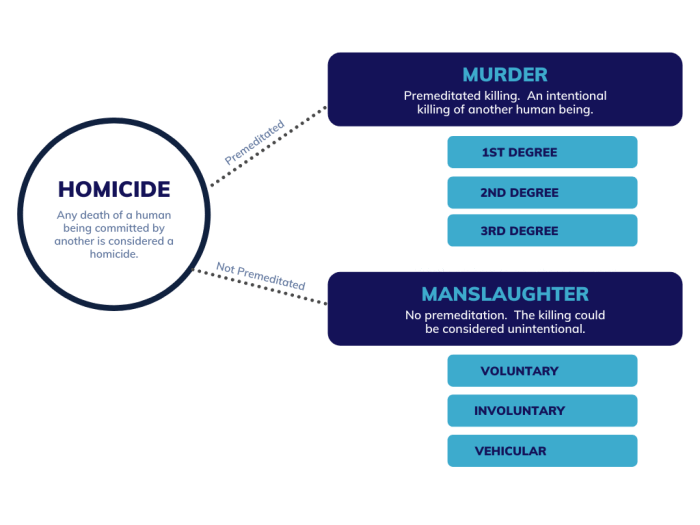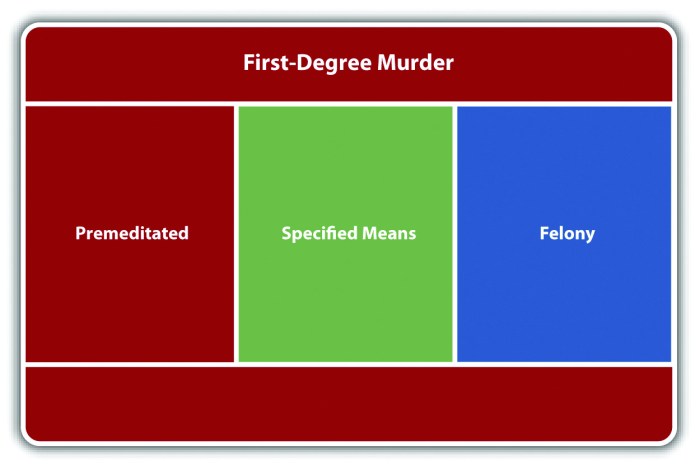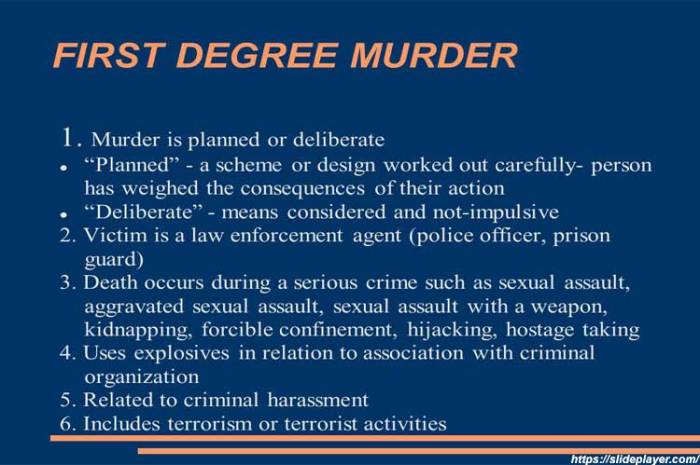What is the worst degree of murder? This question has perplexed legal scholars and captivated the public for centuries. In this article, we will delve into the complex world of murder degrees, exploring the distinctions between each level and the factors that determine the severity of a murder charge.
From the heinous crime of capital murder to the lesser offense of manslaughter, we will unravel the intricate web of laws and legal principles that govern the classification and punishment of murder.
Degrees of Murder: What Is The Worst Degree Of Murder

Murder is a serious crime that can be classified into different degrees based on the intent, premeditation, and other factors surrounding the killing. The distinctions between the degrees of murder have legal implications that affect the sentencing and punishment.
Degrees of Murder
| Degree | Definition |
|---|---|
| First-Degree Murder | Intentional and premeditated killing with malice aforethought. |
| Second-Degree Murder | Intentional killing without premeditation or malice aforethought. |
| Third-Degree Murder | Killing that occurs during the commission of a felony other than murder or manslaughter. |
| Voluntary Manslaughter | Killing committed in the heat of passion or sudden provocation. |
| Involuntary Manslaughter | Killing that occurs as a result of recklessness or negligence. |
The distinctions between these degrees are based on the level of intent and premeditation. First-degree murder requires both intent and premeditation, while second-degree murder requires only intent. Third-degree murder is a felony murder that occurs during the commission of another felony.
Voluntary manslaughter is committed in the heat of passion, while involuntary manslaughter is caused by recklessness or negligence.
Legal Implications
The degree of murder has significant legal implications. First-degree murder is typically punished with the most severe penalties, including life imprisonment or the death penalty. Second-degree murder is punishable by a range of sentences, including lengthy prison terms. Third-degree murder is generally punished less severely than first- or second-degree murder, but still carries significant penalties.
Aggravating and Mitigating Factors

In addition to the degree of murder, courts consider aggravating and mitigating factors when determining the appropriate sentence. Aggravating factors are circumstances that make the crime more serious, while mitigating factors are circumstances that make the crime less serious.
Aggravating Factors
- Prior criminal record
- Torture or extreme cruelty
- Killing for financial gain
- Killing a law enforcement officer
- Killing multiple victims
Mitigating Factors, What is the worst degree of murder
- Diminished capacity
- Provocation
- Self-defense
- Mental illness
- Extreme poverty
Aggravating and mitigating factors are weighed by the court to determine the appropriate sentence. The presence of aggravating factors can increase the severity of the sentence, while the presence of mitigating factors can reduce the severity of the sentence.
Capital Murder
Capital murder is the most serious degree of murder and is punishable by death or life imprisonment without parole. In order for a murder to be considered capital murder, it must meet certain criteria.
Criteria for Capital Murder
- Intentional and premeditated killing
- Killing for financial gain
- Killing a law enforcement officer
- Killing multiple victims
- Killing a witness to a crime
The death penalty is only imposed in the most heinous cases of capital murder. The decision to impose the death penalty is made by a jury or judge, and it is based on the evidence presented at trial and the aggravating and mitigating factors in the case.
Felony Murder
Felony murder is a type of murder that occurs during the commission of another felony. The felony does not have to be violent, but it must be inherently dangerous. The intent to kill is not required for felony murder.
Concept of “Transferred Intent”
In felony murder, the intent to kill is transferred from the underlying felony to the killing. For example, if a robber shoots and kills a store clerk during the course of a robbery, the robber can be charged with felony murder even if they did not intend to kill the clerk.
Defenses to Felony Murder
- Lack of intent
- Withdrawal from the felony
- Lack of foreseeability
- Self-defense
Felony murder is a serious crime that carries significant penalties. However, there are a number of defenses that can be raised to felony murder charges.
Murder vs. Manslaughter

Murder and manslaughter are both unlawful killings, but they differ in terms of intent and premeditation. Murder requires intent to kill, while manslaughter does not.
Key Differences
- Murder requires intent to kill, while manslaughter does not.
- Murder is punished more severely than manslaughter.
- Manslaughter can be voluntary or involuntary.
Voluntary Manslaughter
Voluntary manslaughter is killing committed in the heat of passion or sudden provocation. The provocation must be sufficient to cause a reasonable person to lose control of their emotions and commit the killing.
Involuntary Manslaughter
Involuntary manslaughter is killing that occurs as a result of recklessness or negligence. Recklessness is acting with a conscious disregard for the safety of others. Negligence is failing to exercise the care that a reasonable person would exercise in the same situation.
Defenses to Murder and Manslaughter
- Lack of intent
- Self-defense
- Provocation
- Diminished capacity
There are a number of defenses that can be raised to murder and manslaughter charges. The availability of these defenses depends on the specific facts of the case.
FAQ Compilation
What is the difference between murder and manslaughter?
Murder is an unlawful killing with malice aforethought, while manslaughter is an unlawful killing without malice aforethought.
What are some examples of aggravating factors?
Aggravating factors include prior convictions, use of a weapon, and causing serious bodily injury.
What are some examples of mitigating factors?
Mitigating factors include self-defense, provocation, and mental illness.
